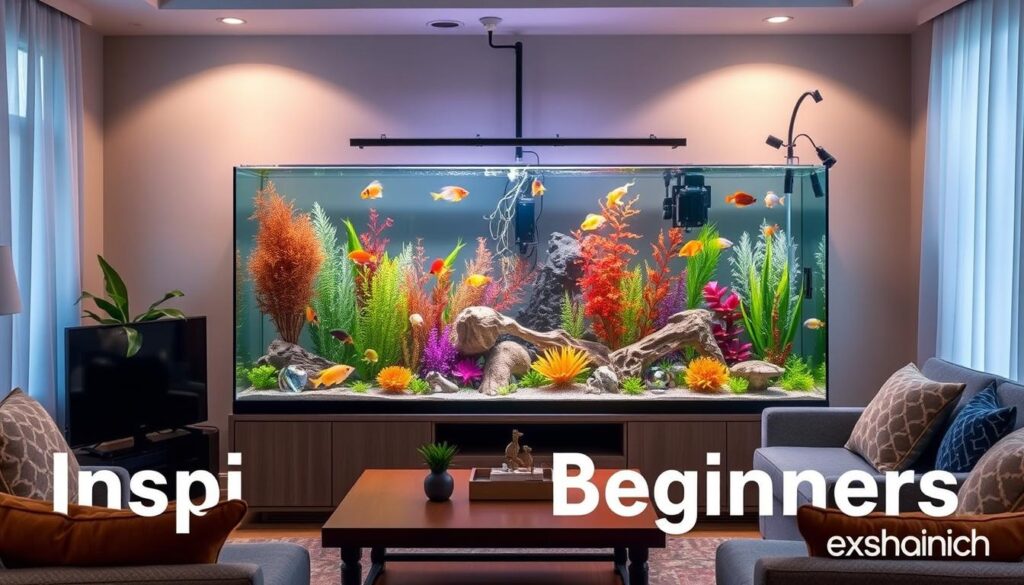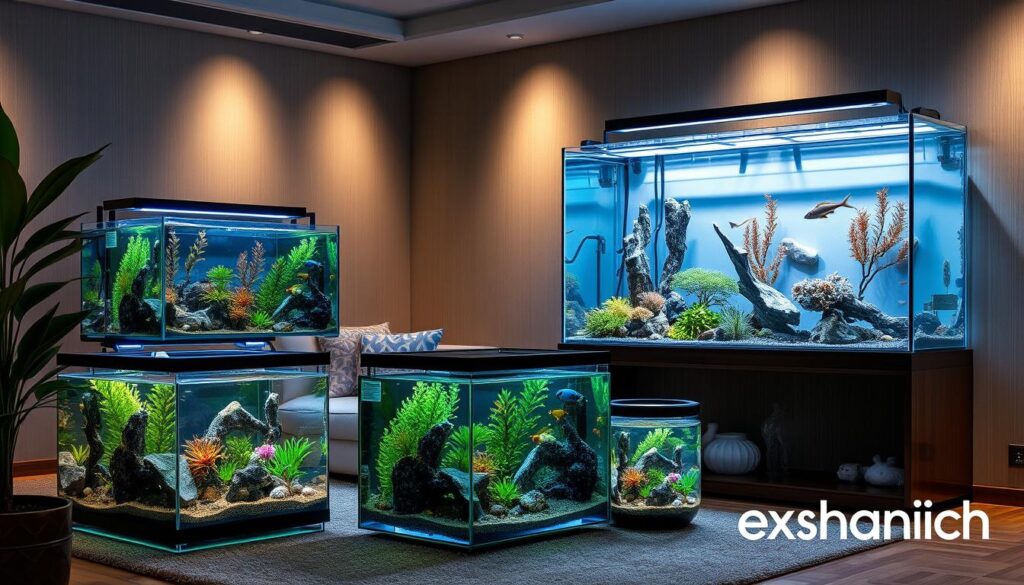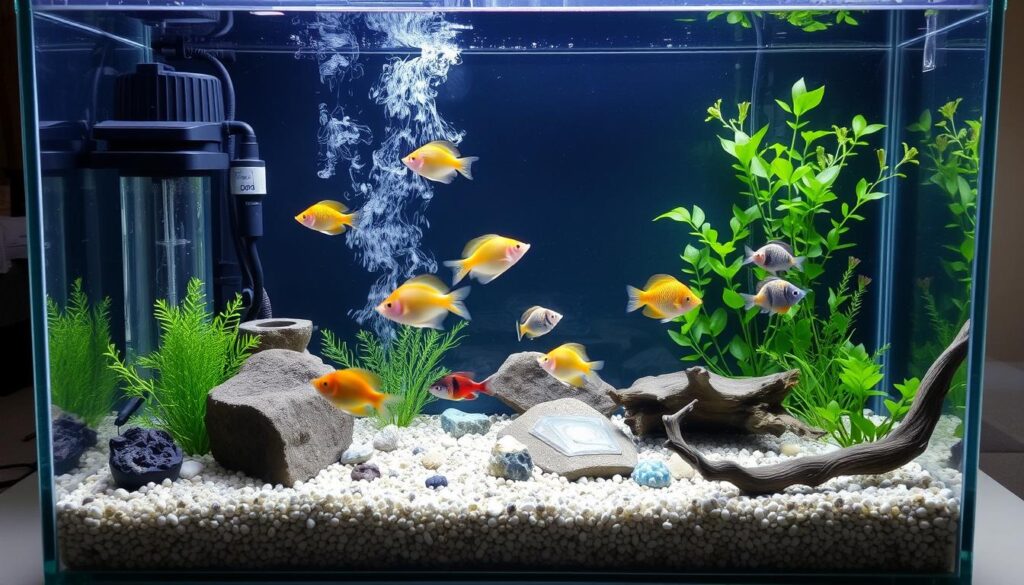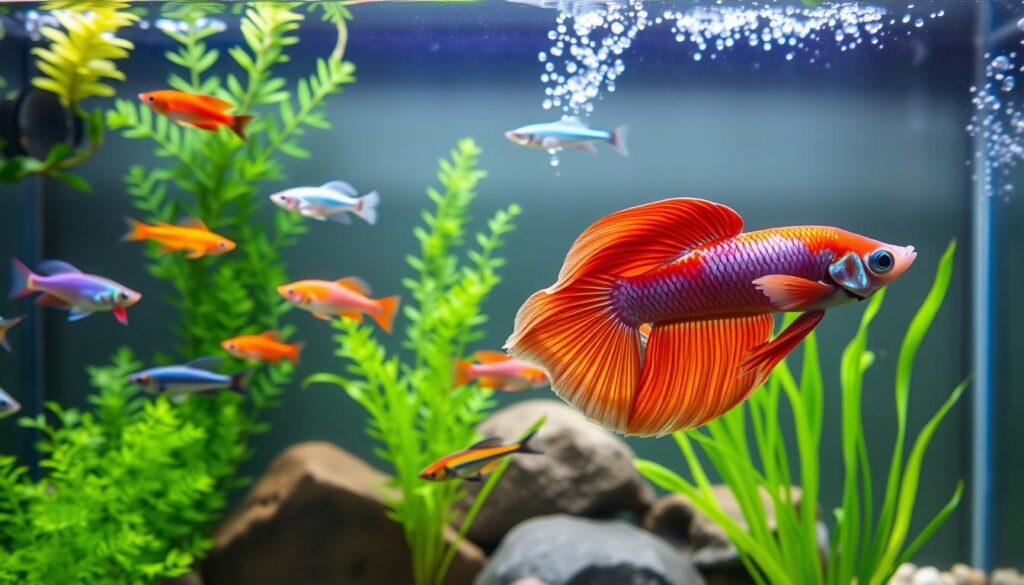Starting your fish-keeping journey can be thrilling and rewarding. But, it’s crucial to begin with the right foundation. As a beginner, the world of aquariums might seem overwhelming. Yet, with the right info, you can pick the perfect aquarium for your home.
This guide will walk you through the key factors to consider. It will help you create a vibrant underwater world in your home.

Key Takeaways
- Understand the differences between freshwater and saltwater aquarium systems to make an informed decision.
- Evaluate the available space in your home and select an appropriately sized aquarium.
- Familiarize yourself with the essential equipment and setup requirements for a successful aquarium.
- Choose fish species that are compatible with your chosen aquarium type and skill level.
- Prioritize water quality and filtration to maintain a healthy environment for your aquatic pets.
Understanding Aquarium Types: Freshwater vs Saltwater Systems
Choosing between a freshwater or saltwater aquarium is your first step. Each has its own benefits and needs. Your experience and commitment to aquarium care will guide your choice.
Benefits of Starting with Freshwater Tanks
Freshwater aquariums are perfect for beginners. They’re cheaper to start and maintain. The water chemistry is easier to handle. Plus, freshwater fish are hardier and simpler to care for.
Exploring Saltwater Aquarium Requirements
Saltwater aquariums need more specialized gear and knowledge. The water chemistry must be closely watched. Saltwater fish are more sensitive to their environment. They’re stunning but require more time and money.
Key Differences in Maintenance and Cost
Freshwater systems need less frequent water changes and tests. Freshwater fish are cheaper to buy and feed. But, saltwater tanks offer a wider range of colorful marine life.
Choosing between a freshwater aquarium or a saltwater aquarium depends on your preferences and budget. Knowing the differences helps you make a choice that suits your needs.
Tank Size and Location: Essential Considerations for Your Space
Choosing the right aquarium size and the perfect spot in your home is key. The tank’s size affects your fish’s health, how easy it is to care for, and how it looks. A good size tank makes your aquarium a beautiful part of your home.
The size of your aquarium is very important. A bigger tank means more room for your fish to swim. It also keeps the water stable, which means less need for water changes and fewer problems with water quality.
- A 10-20 gallon fish tank is great for small to medium-sized homes. It’s a good size for a home aquarium idea.
- If you have more room, consider a 30-55 gallon tank. It lets you have more kinds of fish and looks amazing.
- The aquarium size guide says you need at least 1 gallon of water for every inch of fish. This keeps your fish healthy and happy.
Choosing the right spot for your aquarium is important. Think about how much space you have, how strong the floor is, and how easy it is to get to. A window can add natural light, but watch out for too much sun, which can grow algae.
| Aquarium Size | Suitable Living Space | Key Considerations |
|---|---|---|
| 10-20 gallons | Small to medium-sized rooms | Easier to maintain, less demanding on space |
| 30-55 gallons | Larger living areas | Allows for more diverse fish populations; requires more space and weight-bearing capacity |
| 75 gallons or more | Spacious rooms or dedicated aquarium areas | Impressive display, but demands significant floor space and weight-bearing ability |
By thinking about the size and location of your aquarium, you can make a beautiful underwater world. It will be a great addition to your home and make it feel more welcoming.

Essential Equipment and Setup Requirements
Creating a thriving aquarium is more than just a tank and water. You need the right equipment and setup for your fish’s health. This includes filtration systems, lighting, and temperature control. Let’s look at the key elements for a successful aquarium.
Filtration Systems and Water Quality
Keeping water quality high is key for any aquarium. A good filtration system is a must. Aquarium filtration systems remove waste and toxins from the water. It’s important to choose the right filter size for your tank to keep the water clean and your fish healthy.
Lighting Options for Different Aquarium Types
Aquarium lighting is vital for your aquarium’s look and your fish’s health. The type of lighting needed depends on your aquarium type. LED lights, fluorescent bulbs, and natural daylight are all good options, each with its own benefits.
Heating and Temperature Control
Keeping the water temperature right is crucial for your fish’s health. Aquarium heaters help maintain the perfect temperature. The heating needs vary based on your aquarium type, fish, and location. Monitoring the water temperature is a key part of caring for your tank.
By choosing the right aquarium equipment and accessories, you can create a beautiful and thriving aquarium. It will bring joy and fascination for years.

Choosing the Right Fish for Your Aquarium
Setting up a successful aquarium starts with picking the right fish. For beginners, the wide range of beginner fish types can be overwhelming. But knowing about fish compatibility and tropical fish care helps a lot.
The size of your tank is key. Small tanks are best for calm, small fish like guppies, tetras, or corydoras catfish. Bigger tanks can hold more lively fish, along with live plants for aquariums and aquarium decorations for a lively ecosystem.
It’s also crucial to think about compatibility. Mixing the wrong fish can cause stress, aggression, and even death. Look for species that get along well, considering their nature, water needs, and how they eat.
| Fish Type | Compatibility | Care Requirements |
|---|---|---|
| Guppies | Peaceful, community fish | Moderate, with a focus on tropical fish care |
| Angelfish | Peaceful, can be territorial with own kind | Moderate, with attention to live plants for aquariums |
| Clownfish | Peaceful, do well in pairs or small groups | Moderate, with a focus on aquarium decorations |
Understanding the needs and behaviors of different beginner fish types leads to a peaceful and lively aquarium. This can add joy and calm to your home.

Conclusion
Choosing the right aquarium for your home is a big decision. It needs careful planning and research. Whether you pick a freshwater or saltwater system, knowing the upkeep and costs is key for a great fishkeeping experience.
Think about tank size, where it goes, and the aquarium equipment you need. This ensures your fish live in a safe, happy place. Making smart choices from the start will make your beginner aquarium guide a rewarding journey.
Keeping an aquarium successful means always learning and being ready to change. Keep up with new aquarium maintenance tips. Pay close attention to your fish’s needs. If you need help, ask experienced hobbyists or pros. With hard work and love for the underwater world, your aquarium selection will bring joy and calm to your home.
FAQ
What are the main factors to consider when choosing an aquarium for a beginner?
When starting, think about your home’s space, budget, and the fish you want. Also, consider how much time you can spend on aquarium care. Choosing the right tank size and equipment is crucial for your fish’s health and happiness.
What are the advantages of starting with a freshwater aquarium?
Freshwater tanks are simpler to set up and care for, perfect for beginners. They need less expensive gear and are more forgiving than saltwater systems. Plus, there are many hardy fish species for beginners to choose from.
How do I determine the right size aquarium for my space?
Choose a tank size based on your home’s space and the fish you’ll keep. Bigger tanks are easier to care for and better for your fish. Make sure the tank fits well in your space without being too crowded.
What essential equipment is needed to set up a successful aquarium?
You’ll need a good filter, the right lighting, a heater, thermometer, and a test kit. For certain tanks, you might also need a protein skimmer, live plants, or decorations. These help create a great environment for your fish.
How do I choose the right fish species for my aquarium?
Think about your tank’s size, water needs, and how fish species get along. Learn about the care and behavior of the fish you’re interested in. Start with a few easy-to-care-for fish and add more as you get more experience.



 No products in the cart.
No products in the cart.